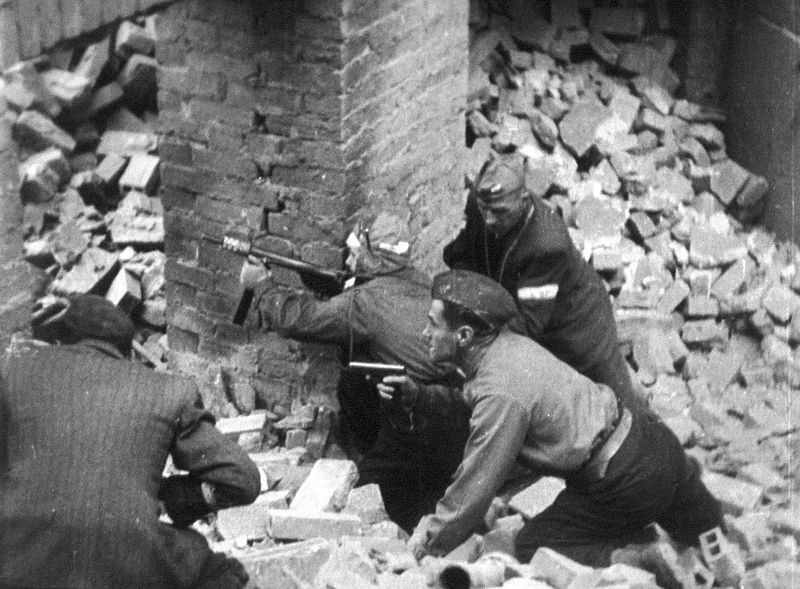The Jewish experience between 1914 and 1948 begins and ends with war. In 1914, WWI began, a watershed in both Jewish history and European history, as it marked the end of four great empires: the Tsarist, Ottoman, Austro-Hungarian, and German Reich. Together, these empires were home to the majority of world Jewry.
In 1916, the physically and ideologically starved Russian populace overthrew the Tsarist government. The successor Provisional Government eliminated legal Jewish discrimination. Before this new freedom could register, however, a new revolution, promulgated by the Bolsheviks, ensued. WWI ended in 1918, but Russian civil war continued through the early 1920s when the Bolsheviks emerged victorious and created The Union of Soviet Socialist Republics. The USSR, organized according to Marxist/Leninist ideology, did not tolerate religion. Government attempts to “convert” the Jews to communism characterized the interwar period.
The collapse of the Ottoman Empire had profound consequences for the Jews, as the Ottomans controlled Palestine, the territory that the World Zionist Organization (WZO, founded 1897) preferred for a Jewish state. During the war, when it became clear that the Ottomans would side with Germany against Great Britain and France, the Allied powers strategized about the fate of the strategically and economically important Middle East. The British were particularly busy strategists, making agreements with three parties regarding the fate of Palestine: the French, the Jews, and the Arabs.
In 1917, after protracted negotiations between the British government and the WZO, Great Britain issued the Balfour Declaration, which stated British support for the establishment of a Jewish homeland in Palestine. This was a tremendous victory for Zionism. At the same time, however, the British offered similar reassurances to the Arabs regarding their rights to Palestine. After the war, as the Allies emerged victorious, the United Nations gave Great Britain the mandate to administer Palestine. Under British rule from 1918-1948, Palestine was characterized by increasingly tense relationships among the British, Jews, and Arabs, all of whom felt that they had the right to the same land.
With your help, My Jewish Learning can provide endless opportunities for learning, connection and discovery.
The Austro-Hungarian Empire dissolved into small, competitive states after the war. Despite promises of minority rights, the nationalist majorities in countries like Poland and Rumania promulgated pogroms (anti-Jewish riots) and fiscal discrimination that resulted in economic collapse. The economic collapse of the Jews in these countries led to a radicalization of Jewish politics. Zionism and Jewish socialism attracted thousands of new adherents. Poland was representative of the interwar Jewish political scene in eastern and central Europe, with all of these movements: general Zionist, Orthodox Zionist, radical Zionist, socialist Zionist, religious non-Zionist, socialist non-Zionist, and the anti-Zionist, anti-Socialist Folkspartei.
The American Jewish community in the 1920s and 1930s aimed to acculturate into the American middle-class, though upward mobility and unbridled acculturation were temporarily tested by the Great Depression and the rise of domestic anti-semitism in the 1930s. The period also witnessed the alignment of the Jewish community with the national Democratic Party. American Jews staunchly supported Franklin Roosevelt, who opened government service to Jews and counted an unprecedented number of Jewish advisors among his inner circle.
The collapse of the German Reich led to a reorganization of the German government after the war. The new Weimar Republic’s pursuit of stability and progress was stymied by war reparations, which resulted in a dangerous combination of popular anger, fervent nationalism, and economic crisis. Such was the atmosphere that occasioned the appointment of the leader of the National Socialist German Workers (Nazi) Party, Adolf Hitler, as chancellor in 1933. In the early years of the Nazi government, Hitler ended German democracy by suspending the freedom of press, speech, and assembly. The 1935 Nuremberg Laws deprived Jews of civil and political rights.
Jews were the main targets of Nazi hatred, but Nazis also persecuted other “inferior” individuals and groups, including Gypsies (Roma), Jehovah’s Witnesses, homosexuals, and the handicapped.
In 1939, Germany invaded Poland and WWII began. German armies marched into Denmark, Norway, the Netherlands, Belgium, Luxembourg, France, Yugoslavia, Greece, and the Soviet Union. Hitler was faced with the addition of millions of Jews to the German “Empire.” The Nazis regarded Jews as a threat to the purity and strength of the Aryan race. They must, argued Hitler, devise a “final solution” to the Jewish problem. This “solution,” agreed upon by German government officials in 1942, was the systematic slaughter of European Jewry using showers of poison gas in designated death camps.
While the Nazis devised and implemented the final solution, they also needed to control existing Jewish communities. Beginning in 1939, Nazis quarantined Jews into ghettos, located in large Polish cities like Warsaw and Lodz, where a Jewish Council (Judenrat), established by the Nazis but staffed by Jews, was responsible for transmitting and enforcing Nazi decrees.
Various forms of Jewish resistance existed in the ghettos and the camps, including armed revolts and more subtle, culturally-based, forms of defiance, like writing cookbooks and celebrating Jewish holidays.
This systematic, bureaucratic, state-sponsored persecution and attempted annihilation of European Jewry by the Nazi regime and its collaborators between 1933 and 1945–in which approximately six million Jews were killed–is known as the Holocaust.



